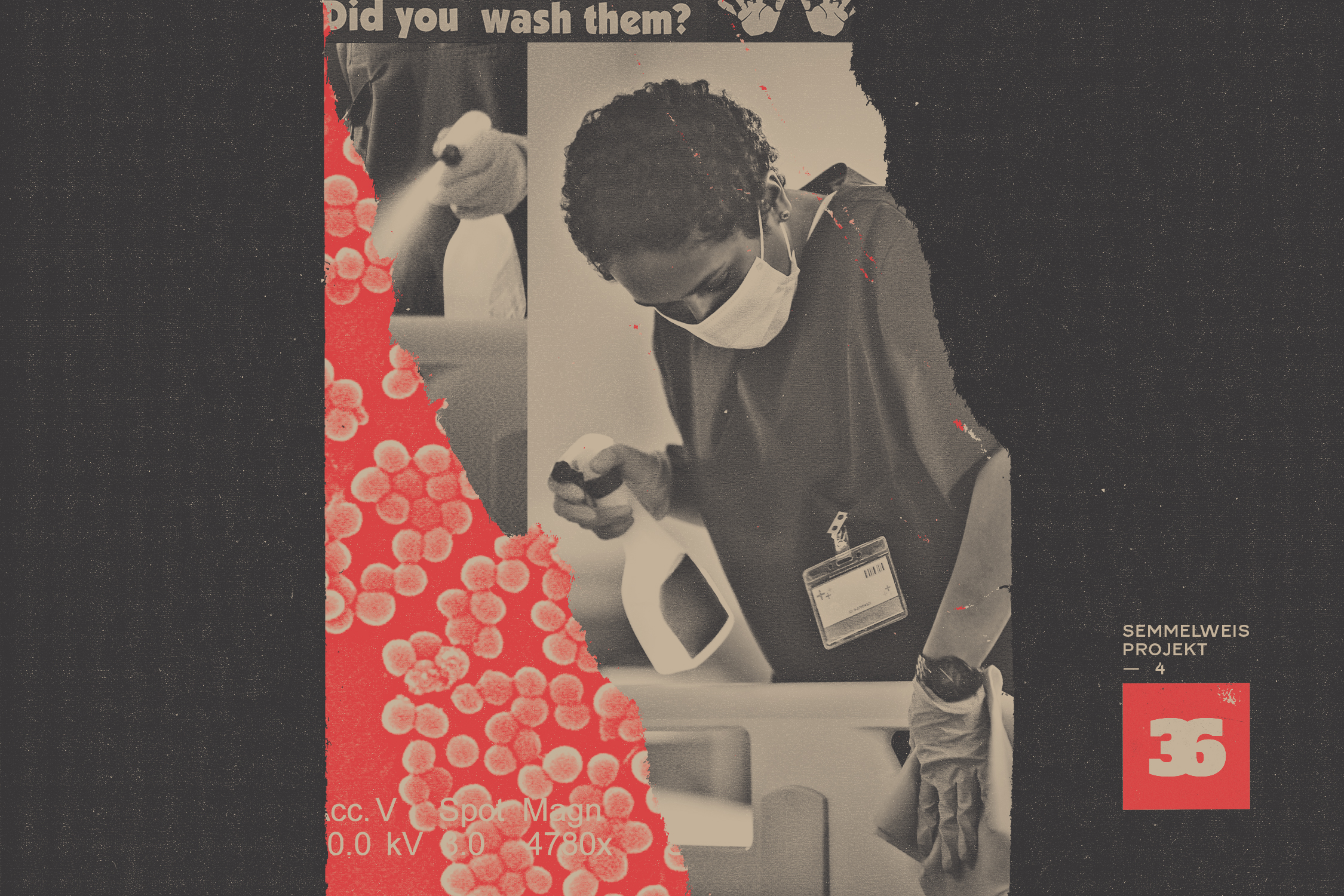In England, the cleaner is the most important person in the hospital. How did other countries manage to decrease hospital-acquired infections?

“I have learned how to wash my hands in England. Once an Indian nurse saw me washing my hands in the hospital. She told me, ‘Doctor, you know you haven’t washed your hands properly this time, don’t you?’ I was so embarrassed being someone who comes from the home country of Ignác Semmelweis…,” recalled Dr. Zsolt Hegedűs, who worked as an orthopedic specialist in England for years and has become a leading figure in the fight against hospital-acquired infections since returning to Hungary in 2015.
He is motivated not only by the impressive results he has seen in the British efforts to control infections, but also by personal reasons. He witnessed the tragic death of a young Hungarian nurse, a former colleague.
“She was due to have hip prosthesis surgery, but a previous abdominal operation had left her with MRSA infection, so they didn’t dare take her on in Hungary. Her operation was always postponed. This may have been a factor in her suicide. She sent her last cry for help to me and I found out the next day in England that she had died in Hungary. It is still a terrible feeling to this day,” the doctor recalled.
According to Hegedűs, proper hand disinfection is not “just a poster on the wall” in the UK system but it is taken very seriously. The same goes for cleaning.
“When I started working in England, the head of my ward introduced me to my colleagues and, introducing the cleaner, said that they were the most important person in the hospital,”
said Hegedűs. He believes that this approach should be adopted in Hungary because human lives and hundreds of millions of forints spent on treating infections could be saved.
In the past weeks, Direkt36 has published a series of articles on the worsening situation of hospital-acquired infections in Hungary. Years ago, the United Kingdom also had a bad reputation when it came to this problem. In the early 2000s, the British health system was still failing to manage hospital-acquired infections.
The number of deaths linked to the superbug MRSA has risen by 2,236% in just over a decade, between 1993 and 2004, researchers found, according to a report by The Guardian in 2006. Only 50 deaths in England and Wales were linked to MRSA (Methicillin-Resistant Staphylococcus Aureus) in 1993, compared with 1,168 in 2004, the Office for National Statistics said, the newspaper reported.
Christine Beasley, the British government’s chief nursing officer at the time, said she found it unacceptable that “anyone should die unnecessarily from infections”. At the time, hospital-acquired infections had been a topic in the British media for years.
In addition to MRSA, there had been a huge increase in the number of infections with clostridium difficile, a bacterium that causes severe diarrhea and dehydration. This received special attention when it was revealed that clostridium difficile outbreaks had occurred in several hospitals between 2004 and 2006, killing at least 90 patients. While the figures have sparked outrage among opposition politicians and the public, the UK Department of Health said “the release of the facts shows their commitment to raising standards.”
Taking up the fight
The devastating figures have prompted the British government to make a change. They set out seven directions for improvement (from investigating the origins of infections to improving hygiene practices and responsible use of antibiotics), launched a hand hygiene campaign and placed alcohol-based hand sanitizer dispensers in every corner of hospitals.
In 2004, a target was set to halve the number of infections, which many thought was impossible at the time. Two years later, the Health Act 2006, a package of laws on the prevention and control of healthcare-associated infections, including a strict code of practice for all hospitals, came into force. Compliance with the code is so rigorously enforced that poorly performing managers could be dismissed for breaking the rules.
The impact of these measures has been more impressive than expected: clostridium difficile infections percent by 2014, and by 2016 MRSA was reduced by 84 percent and bloodstream infections by 78 percent in the intensive care units.
“Today, the British healthcare system monitors hospital-acquired infections broken down by doctors and annually presents the doctors with the results, which they have to reflect on professionally. This way they are monitored and motivated to learn from each case,”
Dr Zsolt Hegedűs told Direkt36. The emphasis is not on blame, he says, but on learning: mistakes are for improvement. Several experts are visiting hospitals and checking the work of doctors. If an infection happens, the doctor must explain it and they discuss how to avoid it next time, the doctor said.
Meanwhile, the British system is communicating the situation quite openly. Hospital-acquired infection results are published on an annual and month-to-month basis, broken down by hospital trusts that operate hospitals. Although some trusts have more than one hospital, in many cases one hospital is managed by these trusts, so it is possible to know how many infections have occurred in a given hospital. Infection control in the country is organized by the National Health Service (NHS) and reports are published on the official government website. A commentary is also uploaded with the annual report, summarising the key data and how it is interpreted.
“In England, hospitals are given a green-yellow-red mark for cleanliness and the prevalence of registered hospital-acquired infections, so patients know clearly what to expect when they enter the institution, and their opinion is also taken into account in the assessment,” Hegedűs explained to Magyar Narancs earlier. The law requires hospitals to publish their assessment in a prominent place in the hospital and on their website. “This evaluation is something that even an 8th-grade graduate can understand,” the doctor said.
Although the US healthcare system works in a fundamentally different way to the European ones, a good example of transparency is the US hospital-acquired infection database published by the federal Centers for Medicare & Medicaid Services. The website allows you to view hospital infection data in different breakdowns, so you can filter by hospital and by state.
In addition, a separate website has been created that allows patients to compare multiple hospitals by selecting one or more hospitals and comparing them based on, for instance, hospital-acquired infections. A guide has also been uploaded to help citizens make “informed decisions”.
„Hospital Care Compare is part of an Administration-wide effort to increase the availability and accessibility of information on quality, utilization, and costs for effective, informed decision-making”, states the guide.
The German approach
The British are not the only ones who want to learn from their mistakes. In Germany, hospital-acquired infections are monitored by the state-owned Robert Koch Institute (RKI) and an independent body called the Commission for Hospital Hygiene and Infection Prevention (KRINKO). The committee also draws up infection prevention rules to be followed in healthcare institutions. Compliance is monitored by local health authorities and hospitals’ teams of experts.
Under the Infection Control Act, introduced in 2001, all German hospitals are required to monitor certain types of infections that are common in their region, which hospital staff is then obliged to analyze and report to the authorities. The latter regularly assesses and monitors the performance of hospitals.
Although infection data by hospitals in the country are not publicly available, authorities do not sweep under the carpet when a particular bacterium causes serious problems. Multi-drug resistant pathogens were also alarmingly prevalent in Germany in the early 2000s, and the Robert Koch Institute’s solution was to coordinate health institutions regionally. More than 100 regional networks have been set up across the country, and since 2004 their representatives have met every 2-3 years to exchange experiences and learn from each other.
When asked exactly how hospital-acquired infections in Germany have evolved over the past 20 years, the Robert Koch Institute did not give a detailed answer, but said that clostridium difficile has declined since 2018, despite the coronavirus epidemic, and MRSA has decreased among multi-drug resistant pathogens, but there were antibiotic-resistant bacteria that were on the rise.
In addition to the RKI, another German network is involved in the fight against hospital-acquired infections. A program called Krankenhaus-Infektions-Surveillance-System (KISS) was launched in the late 1990s by the National Reference Centre for the Surveillance of Nosocomial Infections (NRZ) voluntarily with the participation of only a few hospitals.
The program has expanded year after year and, although participation is still not compulsory for hospitals, the NRZ told Direkt36 that
„many hospitals choose to participate in KISS as it helps structure their local surveillance efforts”.
The World Health Organization’s 2022 report also points out that one of the biggest advantages of the KISS system is that it functions as a network whose members can learn from each other’s successes and failures because the data is used to improve staff and the institution. Regular monitoring and feedback have also been able to reduce hospital-acquired infections by 20 to 30 percent in particularly infection-prone wards such as intensive care and surgical wards.
Austrians are following the German example

The AKH in Vienna – Source: Wiener Gesundheitsverbund / Mayer-Egerer
The Allgemeines Krankenhaus der Stadt Wien (AKH) in Vienna is one of Europe’s largest hospitals, with nearly 9,000 employees, and has been ranked among the world’s best for several years. In 2023, the AKH was ranked 30th in the annual list of Newsweek and Statista, which this year included 7 other Austrian institutions. The huge Austrian public hospital, together with the Medical University of Vienna, runs 29 university clinics with nearly 400 outpatient clinics and treats around 60,000 inpatients each year.
This is where Beáta Dunavölgyi is working as a nurse. She has worked in several hospitals in Budapest before moving with her school-age son and their dog to her 68-square-metre apartment near the Ottakringer terminus in Vienna. Her workplace, the two massive 22-storey buildings of the AKH, can be seen from her window. She currently works 38 and a half hours a week in the Infectology Laboratory.
Dunavölgyi said she still loves her job after 35 years. She has worked in trauma surgery, oncology, nephrology and intensive care in Hungary, and the AKH was a huge contrast to her experiences in Hungary.
“When I came to Vienna, my jaw dropped. They disinfect all the time, every single ward has hand sanitizer and hand wash, the mop water here has everything, you could eat off the lab and operating room floors,” she said.
She also said that cleaning is taken very seriously at the AKH. “There are supervisors who check the cleaners by having an invisible pen that they use to mark the toilets, door handles, taps, cupboard tops, and then they come afterward with the UV lamp and check if they have been cleaned. It’s a daily routine,” the nurse explained.
When contacted by Direkt36, the AKH confirmed that the cleaning is carried out by trained staff according to strict standards. “If weak points are identified during the quality checks, appropriate follow-up training and instructions are provided”, they wrote.
The Austrian hospital also described that “when selecting the cleaning company, the decision was made based on the best bidder principle (not the lowest bidder) so that our criteria were met”.
(In contrast, as we reported in the third part of our series, a former senior hospital cleaning source told Direkt36 that in Hungarian hospitals “the cheapest always wins” in cleaning tenders put out by hospitals.)
Hungarian nurses would be in tears
According to Dunavölgyi, the procedure when new patients arrive at the Austrian hospital is also revealing.
“There’s a central laundry, the staff come and take the whole bed down as it is, take the linen off, disinfect the beds with a machine, put the clean linen on and then it’s put back on the ward”,
the nurse said, adding that if someone at the AKH catches a hospital-acquired infection, they are sent to a separate room with the name of the infection written on the door. The room also has a separate anteroom where protective equipment awaits the nurse. In the anteroom, the patient changes clothes and throws away the equipment used, so that nothing that was in the room is left in the corridor. The department immediately reports the incident to the hospital director.
“Of course, hospital-acquired infections happen here too, but they correct them immediately, for example by replacing the air conditioner if they suspect it might be the cause. There are no secrets, the hygiene team comes immediately and tries to correct it. Everything is under constant control, and they also take samples of our hands spontaneously to check if they are clean,” explained Dunavölgyi, who says that these things are then fixed in the minds of the workers during regular implementation.
“You get used to the rhythm, the sequence of washing your hands, and then you can’t go wrong and see that it makes sense,” she added.
The AKH’s press office wrote Direkt36 that “data regarding HAI surveillance, outbreaks and the respective interventions are communicated and implemented in cooperation with the healthcare personal and doctors in charge who consider possible consequences”.
Another source, who asked to remain anonymous, told Direkt36 about similar experiences after 15 years working in the Hungarian health sector, before finding a job in a Viennese hospital in 2012.
“If my colleagues saw that this is how it is done, that it is possible to work like this, they would be in tears”,
they explained to Direkt36 what their first thought was when they were shown around the Vienna hospital. In the intensive care unit the source said, “in addition to the support staff, there is one graduate nurse and one specialist nurse per patient, and if a doctor has to examine 4 patients, that’s 4 changes of clothes, 4 aprons, 4 pairs of gloves”. The source added that, in contrast, they remember well the working conditions at a large Hungarian hospital where they washed the gloves by hand. “We didn’t have enough gloves, so we disinfected the ones we used, dried them and used them again,” said the nurse.
The gap between Hungary and Austria
According to a 2016-2017 study by the European Centre for Disease Prevention and Control (ECDC), the prevalence of hospital-acquired infections is the same in Austria as in Hungary. Yet there is a huge difference between the two countries, with Austria having five times as many blood sample tests and almost four times as many stool sample tests per 1,000 patient days than Hungary, according to the study. The number of tests affects the number of infections detected, so it is likely that Hungary would have a much higher official infection rate if more tests were carried out in hospitals.
As we have shown in previous articles in this series, Hungarian hospitals sometimes fail to report even the infections they do identify. The National Centre for Public Health and Pharmacy (NNGYK), which is responsible for monitoring infections, has also admitted that hospitals are reporting infections “loosely”.
Although Austria does not publish more data than Hungary, there is a huge difference in infection prevention practices.
In 2016, the Austrians launched a project called A-HAI, which covers the monitoring of all hospital operations, and the Ministry of Health is also working with the German Robert Koch Institute to establish a well-functioning surveillance and monitoring practice in Austria.
The cooperation has proved successful. The country saw a huge rise in clostridium difficile cases in the mid-2010s, with more than 6,000 people affected by diarrheal disease each year for 3 years after 2015, which Jasmin Memeran, a spokesperson for Austria’s health ministry, told Direkt36 was when more tests started to be carried out. By 2019, this number had fallen below three thousand, and by 2021 it was even lower.
“In the years of the COVID-19 pandemic, a decrease is observed, likely due to infection control measures and pandemic-related measures. 2020 data was excluded due to pandemic-related incomplete data delivery”, Memeran explained.
By contrast, in Hungary, these were the years during which the incidence of hospital-acquired infections spiked. Dr. Ágnes Galgóczi, department head of the NNGYK, explained this by the fact that healthcare institutions “could not prepare for proper isolation, and the patient material changed”. Hospitals have received more seriously ill patients who are more vulnerable to infections, and the coronavirus outbreak has also led to a higher number of healthy people requiring intensive care, which may have also increased the incidence of hospital-acquired infections.
We did not receive a reply from the NNGYK when we asked why the same conditions in Austrian and German hospitals had led to a reduction in some hospital-acquired infections.
In the first part of our series of articles, we showed how officials try to hide infection data, and in the second part we published a ranking of hospitals by the incidence of hospital-acquired infections. In the third part, we explored how hospital conditions play a role in the spread of infections.
To follow further articles in this series, sign up to receive alerts on our investigations.
Cover photo by Péter Somogyi (szarvas) / Telex



